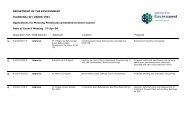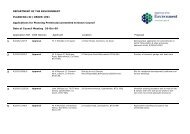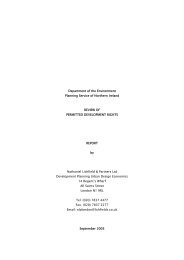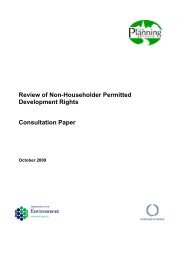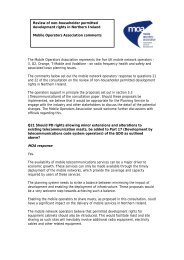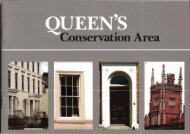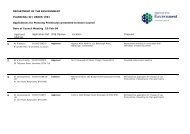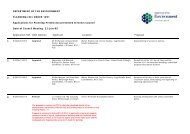Caledon Conservation Area Booklet September 2003
Caledon Conservation Area Booklet September 2003
Caledon Conservation Area Booklet September 2003
Create successful ePaper yourself
Turn your PDF publications into a flip-book with our unique Google optimized e-Paper software.
The settlement of <strong>Caledon</strong> started<br />
Iie in late medieval times. Then,it<br />
was known as Kinatd (orKinafrd),<br />
meaning 'high head' or 'topof the<br />
hill'.<br />
"The Annals of the Four Masters"<br />
records a settlement at Kinard,<br />
during the 150s. This probably<br />
amounted to a small collection of<br />
timber and thatched dwellings,<br />
close to the castle, possibly on the<br />
site of the present village. In 1514,<br />
this small settlement appears to<br />
have been 'put to the torch' and, In<br />
1531, the castle itself was largely<br />
dismantled during a siege. A later<br />
map (by SirJosiasBodley and<br />
dating from c.1609) indicates that<br />
the settlement also pssessed a<br />
church.<br />
In 1614, as part of rhe Plantation of<br />
Ulster, the 'Manor of Kinnard was<br />
granted "to Catherine Ny Neale, (sic),<br />
w'fi of the late T ~ Cor TirIagh P Oge<br />
Oweale and now wife of ROM<br />
Hmden, gent.# A litany of<br />
townland names follows... The<br />
Grant concludeswith reference to<br />
its being for Catherhe's life and<br />
passing to "...Felimy Roe O'Neale,<br />
her son and his heirs forever ...the<br />
whlepremises are created into the<br />
Manor of Kinard, with 500 a m ir~<br />
demesne..."Philip Robinson records<br />
that Catherhe's grant amounted to<br />
2,620 a m in the baronies of<br />
Dungannon and 'ITrannywhich<br />
extended into county Armagh. By<br />
1618119 and the time of the report<br />
of Captain Nicholas Pynnar on the<br />
progress of the Plantation, for<br />
<strong>Caledon</strong> nothing is recorded. This<br />
may have been an oversighton<br />
Pynaax's part or-because it was<br />
occupiedby nativepnms rather<br />
thanpianted with English, Welsh or<br />
Scots Undertakm-perhaps it did<br />
not interest him...<br />
Following the 1641Rebellion and<br />
the Restoration, after a long time<br />
with no owner, by letters patentdated<br />
2P February and lSmJuly<br />
16Gthe encumberedKinard<br />
Estate of Su Phelirn OtNeill,<br />
executed in Dubltn in 1653 for his<br />
leading role in the RebellionIwas<br />
granted to Captain William<br />
Hamilton, "furhis sw'ces to the<br />
Royalist came, during the Civil W&.<br />
It may we11be that Hamilton<br />
named thie estate "Caldon",after<br />
his native Scotland, (which the<br />
Romans had named <strong>Caledon</strong>ia), it<br />
could be a corruption of the word<br />
'Culligan', a townland within the<br />
demesne, or--according to an old<br />
Church of Ireland direct0ry for the<br />
Armagh Diocese-it could mean<br />
'Fort in the marshy meadow"...<br />
There Is little mrce material<br />
concerning <strong>Caledon</strong> during this<br />
period. The village is indicated on<br />
Herman Moll's 1714 map of<br />
Ireland, howewr, in which it is<br />
marked (as 'Kimzardat Csllidmt,<br />
the village adjoining the estate)<br />
aIong the road from Monaghan to<br />
Dungannon, suggesting that the<br />
axis of the village was north-south<br />
at that time, as it is now.<br />
Herman Moll map, 1714.






